Dynamic neutral postures are the ergonomic standard for healthy computing over long periods. This concept first landed from outer space in 1973. It then went on to dictate the back support standards for cockpits, car seats, and office chairs. This article clarifies NASA’s Neutral Body Posture (NBP) discoveries. Then it tracks the evolution of that technology. Circa 2023, there are nine neutral posture variations for seated computer users to consider.
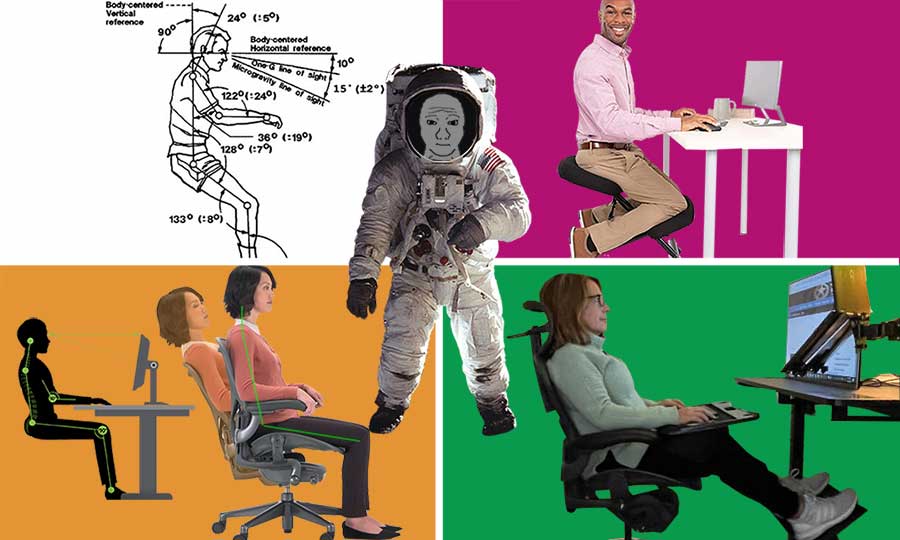
Neutral body postures were first discovered in 1973. Then, NASA scientists observed astronauts in zero gravity aboard the Skylab Space Station. When relaxed, their bodies naturally fell into neutral positions.
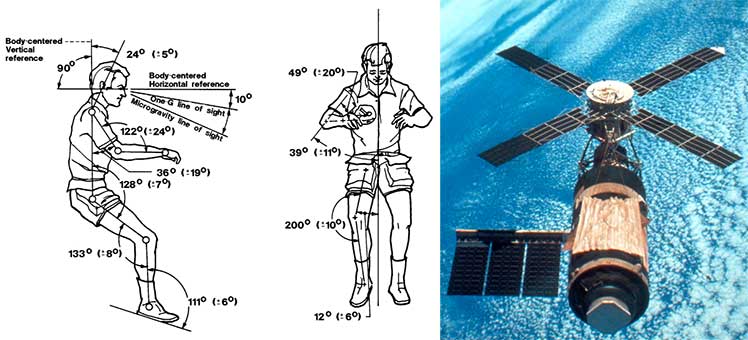
These positions reduce the body’s need to exert against gravity’s pull. That offloads musculoskeletal stress, reducing massive pressure on the spine.

In 1987, NASA first published its findings(1). Its guidelines powered future spacecraft designs, cockpit ergonomics, and race car seats. In the 1990s, this technology went mainstream, manifesting as ergonomic car seats and office chairs.
Evolving Ergonomic Seating Definitions
In 1994, the 1st edition Handbook of Human Factors and Ergonomics compiled leading institutional studies documenting neutral sitting standards for ergonomic office chairs.
That provided the foundation for other institutional leaders like OSHA and BIFMA to draft their own ergonomic seating guidelines.

The functional gist: to qualify as ‘ergonomic’, a chair needs three adjustable features. Adjustable lumbar support aligns the spine; adjustable armrests offset arm weight; a reclining backrest lets you set custom angles.
By 1999, several comprehensive recaps had been published. This summary of sitting biomechanics (2) explained the relevance of the adjustable trinity:
- A seated recline of 100-130° — with a supported lumbar curve — exerts the least spinal disc pressure.
- Electromyography readings show that adding armrests or tilting the seat up by 5° reduces disc pressure even more.
- Seating that lets users frequently change positions promotes longer sitting sessions by relieving musculoskeletal stress.
The point: to support users into healthy neutral sitting postures.
Neutral Sitting Posture Biomechanics
Neutral postures replicate the back angles maintained by a healthy standing spine. Specifically, a healthy standing spine maintains a 25-45° lower back curve.
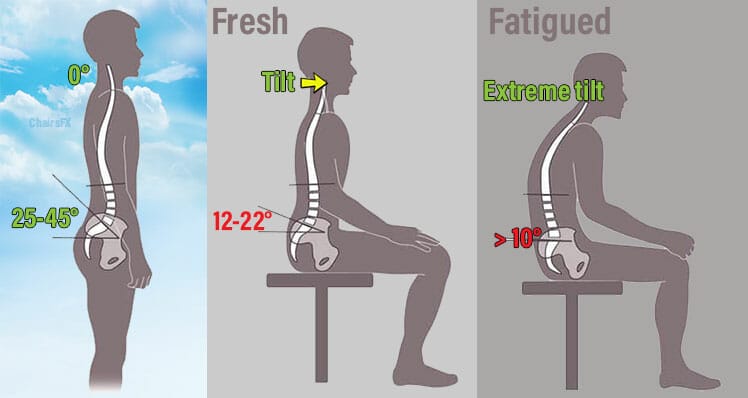
Sitting without support flattens that curve by around half(3). Then, the back muscles must work harder to hold the torso upright. When muscles tire, postural integrity collapses.
The solution: use an ergonomic chair with a supported lumbar + adjustable arms + customizable recline. Then, sitting with planted feet and tucked hips induces a healthy neutral posture.
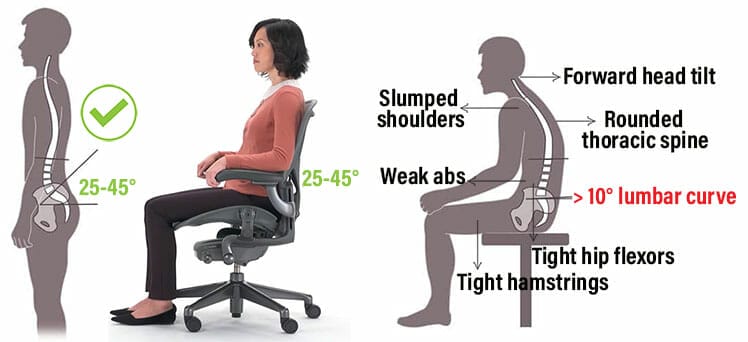
This is why neutral sitting postures look similar in all types of ergonomic chairs. In fact, any chair with the adjustable lumbar + arms + recline trinity has the potential to yield similar results.
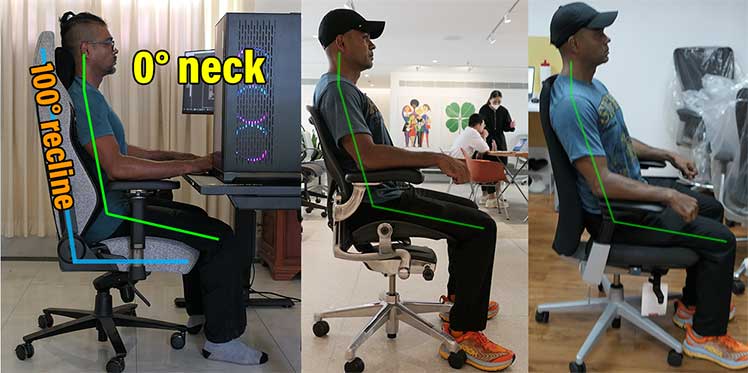
In my experience, it doesn’t matter if you use a gaming or ergonomic office-style chair. See how both use the same components to support similarly neutral postures:
Next Wave: Multi-Device Ergonomics
Neutral posture ergonomics didn’t evolve much since the first 1994 edition of HFE. Later editions added insights into evolving computing standards. These manifested as updated design priorities in 2021.
The 2021 (5th edition) HFE switched from a desktop computing back support focus to prioritizing optimal human-computer interaction (HCI). This is in support of a planned World Economic Forum 4th Industrial Revolution.

The revolution aims to plug the masses into an Internet of Things (IoT). Then, humans will supposedly exist in a state of perpetual, near-virtual reality.
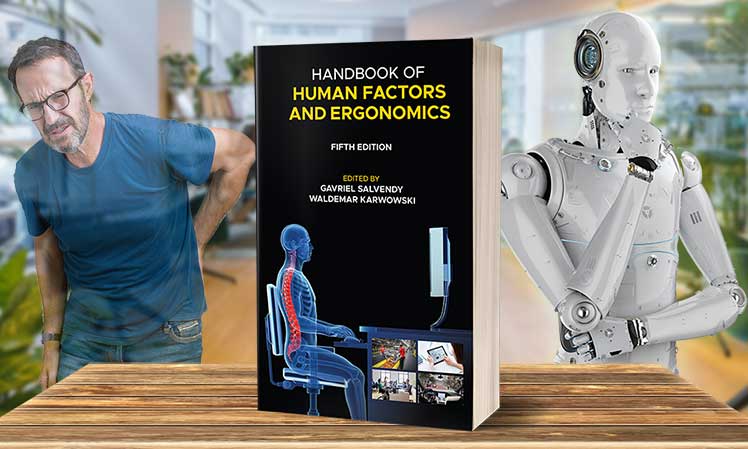
The problem: humans are not designed to be plugged into computers for long periods. To ensure a smooth transition, ergonomist design objectives now go well beyond basic back support. These are the leading 5th edition priorities:
- Multi-device support: a modern ergonomic setup should support simultaneous PC and device operation.
- Physical technostress: extended device usage increases the risks for musculoskeletal disorders.
- Mental technostress: display arrangement must help users process data without cognitive overload.
Good back support still remains a priority in the 2021 5th edition. But now it’s a foundational priority that must be built upon.

With good back support in place, workplace designers must also seek to alleviate cognitive overload, sedentary stress, and other HCI problems. Learn more:
Technostress: Physical & Mental Health Computing Disease
5th edition HFE Summary: Multi-Device Ubiquitous Computing: New Ergonomic Frontier
Neutral Posture Science Benchmarks
NASA’s neutral posture discoveries eventually powered the development of ergonomic car seats. The former is an active upright neutral posture; it uses back muscles for stability.
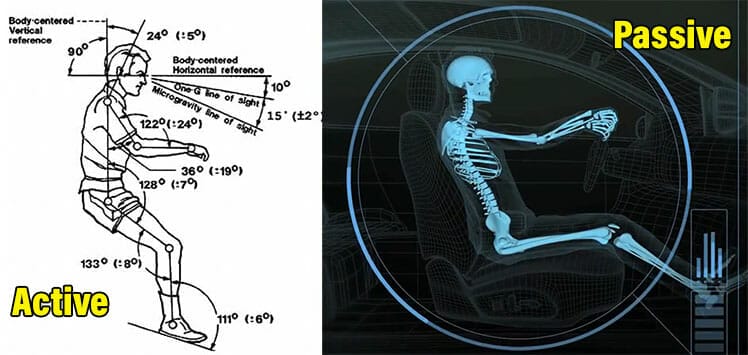
The latter is a passive reclined posture. There, back muscles aren’t needed to stabilize the spine. Instead, ergonomic support provides stability plus optimal spinal alignment.
These active and passive neutral posture extremes are benchmarks. Between them are nine healthy neutral computing variations for modern computer users.
NASA 1973 Neutral Body Posture (NBP)
NASA Human Factors and Health Technical Standards (NASA STD-3000) specify NBP as a reference posture(4). This posture occurs during weightlessness. It reduces the body’s need to support itself against the pull of gravity.
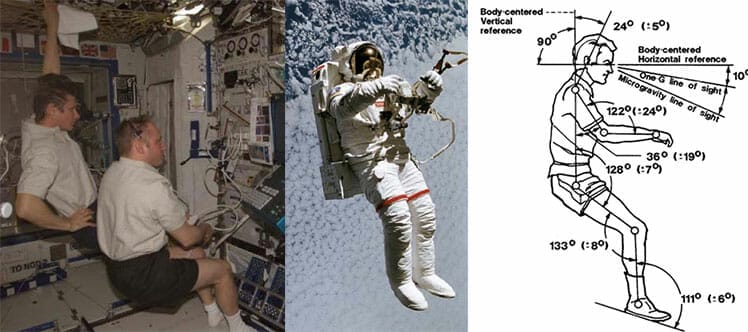
That offloads musculoskeletal stress, reducing pressure on the diaphragm and spine. Significantly, neutral postures support the spine’s natural curves.
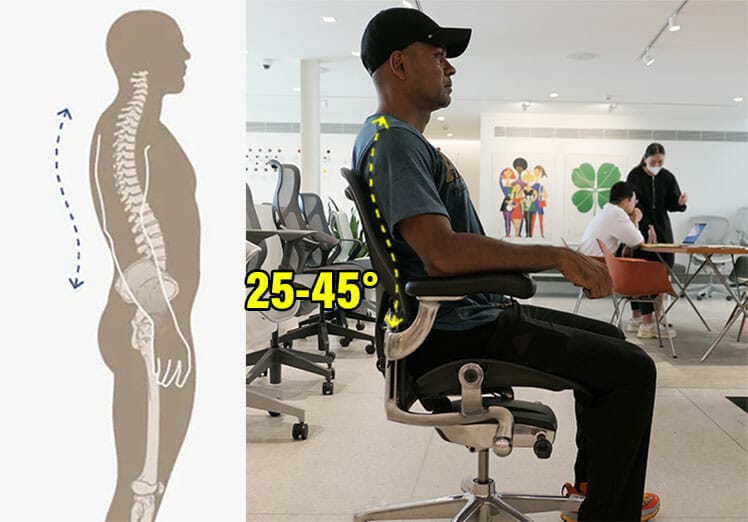
A neutral spine not experiencing mechanical stress will curve inward at the neck (cervical region), outward at the upper back (thoracic region), and inward at the lower back (lumbar region)(5).
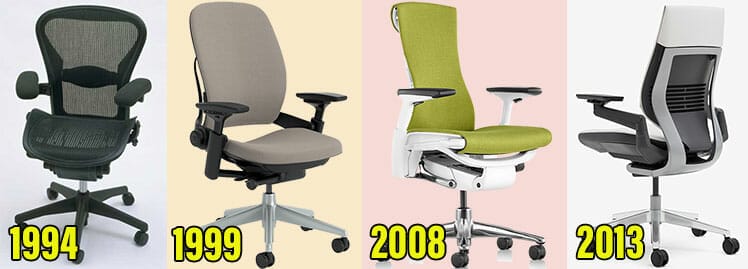
These concepts fuelled the back support of the world’s earliest ergonomic desk chairs. Herman Miller kicked off the revolution with the Aeron office chair in 1994. Steelcase replied in 1999 with the Leap chair. Learn more:
Car Seat Neutral Postures
In 1987, NASA documented NBP into the Man-Systems Integration Standards (MSIS) NASA-STD-3000. This outlined ways to encourage neutral body postures across various industries. Doing so was hyped as being beneficial to human health, safety, and productivity.

Soon after, the U.S. auto industry crashed. After the 9/11 attacks in 2001, the economy fell into a deep recession. By 2005, oil prices started rising. Sales of gas-guzzling American cars plummeted.

To boost flagging sales, Nissan Motor Company engineers used NASA’s MSIS research to develop ergonomic car seats.

In 2006, Nissan published a study on its effectiveness. It found that its prototype seat effectively supported the spine from the pelvis to the head. That, as a result, improved blood flow.
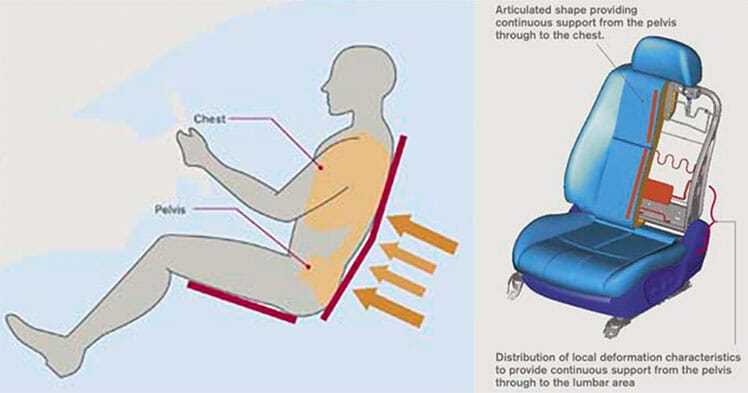
The driver was able to maintain a near-perfect NBP in the prototype seat. That significantly reduced fatigue over long periods of sitting(6).
Summary of Neutral Computing Styles
Here’s a summary of neutral posture variations. All fall between the benchmark active upright vs passive reclined neutral posture extremes.
Some of these I’ve tested — and found viable — in-house. Others come recommended by world-leading esports doctors and physical therapy ergonomic experts.
- Textbook Lumbar-Powered Neutral: planted feet + tucked hips + 110-130° recline = good lower back but poor upper back postures.
- Sloppy Semi-Neutral Upper Slouch: a sloppier textbook-neutral posture with a more extreme upper back slouch.
- Sloppy Semi-Neutral + Movement: common among esports pros. Sloppy slouched postures get offset by movement breaks + fitness.
- Full-Back Gaming Chair + 0° Neck: a textbook neutral posture for the back and neck using a gaming chair + headrest. Needs strong back muscles.
- Mid-Back Office Chair + 0° Neck: neutral posture for the back and neck using a mid-back chair without a headrest. Strong back muscles are not necessary.
- Non-Neutral Forward Gamer Lean: this posture can ruin your spine. But science has proven that it helps video game players perform better.
- Active Upright + Passive Combo: a famous esports doc shows off healthy gaming postures that reflect original active vs passive benchmarks.
- Passive Reclined Gravity Hack: a modern riff on ergonomic car seat benchmarks; lets gravity provide posture support instead of back muscles.
- Standing Desk + Ergo Chair: meets modern ergonomic standards with multi-device support + supercharged movement (sedentary relief).
Textbook Lumbar-Powered Neutral
I first started using gaming chairs in mid-2017. It took me around six months to figure out a neutral sitting method using textbook ergonomic definitions.
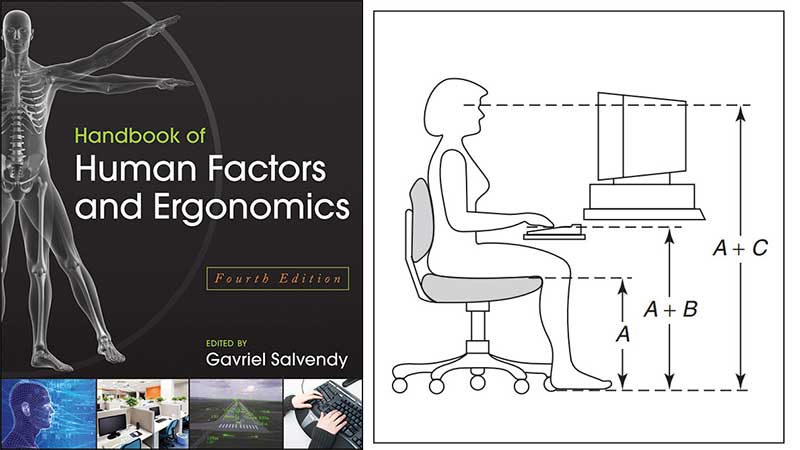
Key points that defined my strategy:
- The 2012 Human Factors Handbook documented institutional design standards of that era. In sum, adjustable lumbar support and arms + a reclining backrest = ‘ergonomic’.
- Dr. Alan Hedge of Cornell University wrote a 2013 ergonomic summary. Lumbar disc pressure and back muscle activity are lowest with a supported recline of 110° – 130° .
- Optimal Posture of the Seated Lumbar Spine is a summary compiled in 2009. Its formula: use a 110° back angle + lumbar support 4 cm deep (slightly above the beltline). Then, lumbar lordosis averages a healthy 47° angle(7).
Supporting Strategic Considerations
Beyond the above three points, some other bits and pieces helped to define my neutral sitting strategy:
- When standing, the optimal lordotic angle is between 20-45 degrees.
- Unsupported sitting reduces lumbar lordosis by 50%. It also increases intradiscal pressure at the third lumbar vertebra by 40%(3).
- When sitting with a back angle of 100-110° and a lumbar support 4 cm deep, lumbar lordosis averages a healthy 47° angle.
- The depth of the lumbar support depends on the individual. If lumbar support causes discomfort, it means it is set too high, too low, or too deep.
- A sustained lordotic sitting position decreases disc pressure and thereby disc degeneration.
Results: Neutral Posture Benefits 2017-2021
After over a decade of slouching in non-ergonomic office chairs, I upgraded to a DXRacer Formula Series in early 2017. Once I figured out how to apply the above techniques, the results were life-changing.

As the chair took over the work of supporting my back muscles, I enjoyed a surge of energy. That yielded super-sharp cognitive focus. Next came a greater awareness of my posture and surroundings while computing.
In April 2021, I put out a Youtube video How To Sit In A Gaming Chair showing my technique.
However, many esports doctors tout the same mantra:
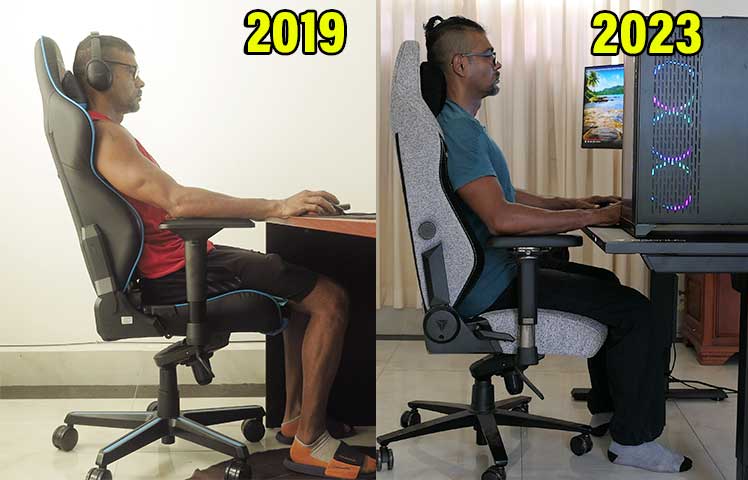
To that end, what worked well for me from 2018 to early 2021 didn’t last. In fact, compared to my current strict neutral posture, my old textbook lower back support method looks sloppy and unhealthy.
Sloppy Semi-Neutral Lumbar
Many amateur and pro gamers use sloppy, quasi-neutral postures while playing video games. Regardless of what type of chair they use, many tend to lean forward. That flattens the lower back curve and rounds the upper spine.

But despite the physical drawbacks of a forward-leaning style, many prefer gaming this way. For example, Oleksandr ‘s1mple’ Kostyljev plays CS:GO player for Natus Vincere.
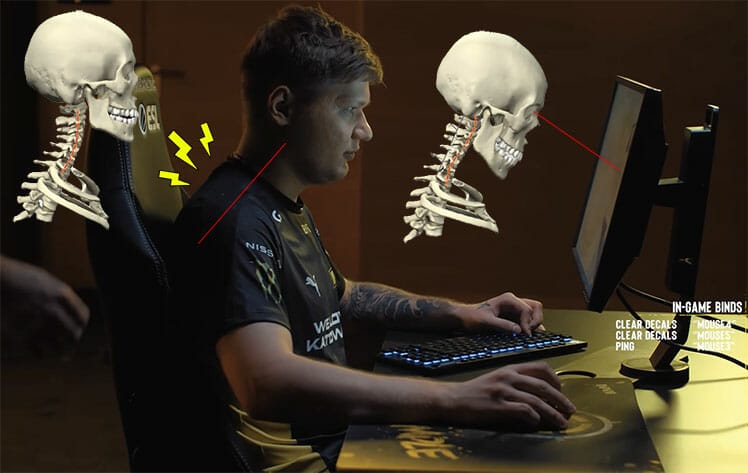
His 2022 gaming setup Youtube walkthrough(8) adheres to textbook lumbar-powered guidelines (supported lumbar + arms but no neck posture target). That maintains a supported lower back well enough to prevent pain.

Many esports pros show off similarly sloppy gaming postures. Despite that, many thrive to reach the highest levels of excellence. If sloppy sitting is harmful, how is this possible?
Esports Pros: Movement > Chair Postures
These days, most elite esports teams also employ nutritionists, sports psychologists, and performance optimization doctors.
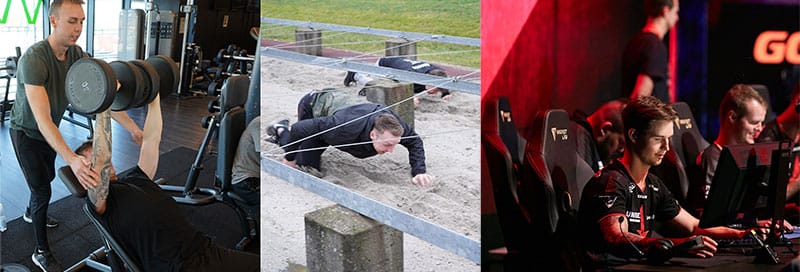
Their strategies echo what many esports doctors have advised ChairsFX in the past. For instance, Dr. Jordan Tsai does physical therapy consulting for many of the world’s elite esports teams (Evil Geniuses, Cloud9, etc).
In my experience, this approach works. With enough movement in your routine, sloppy postures work fine.

As proof of that concept, I enjoyed several years of pain-free comfort using semi-neutral postures + movement. In my case, that involved:
- Shifting positions in the chair every few minutes.
- Taking walking or stretching breaks every 15-30 minutes.
- Going to the gym 4-5 times per week to lift weights and strengthen my muscles.
Full-Back Gaming Chair 0° Neck
The 5th edition Handbook of Human Factors and Ergonomics was published in August 2021. It’s a super-dense 1502-page summary of multi-device ubiquitous computing design standards. It took me several months of power-skimming before I comprehended the gist:
In April 2022, I self-tested my posture for signs of text neck syndrome. First, I removed the headrest on my Secretlab Titan 2022 chair. Then, I tried to sit as straight as possible by exerting my back muscles.
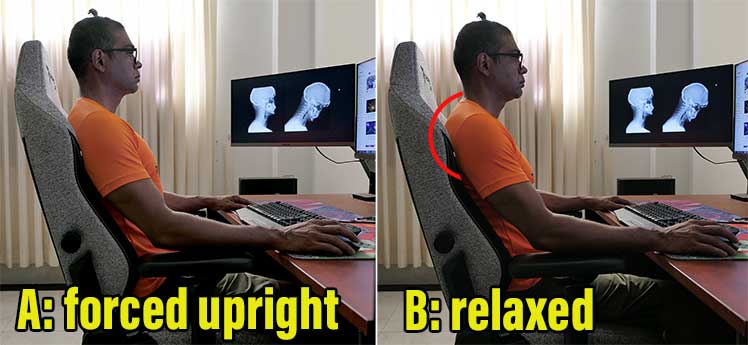
After that, I relaxed my muscles to gauge my natural sitting posture. The results shattered my assumption of having good posture!
DIY Text Neck Gaming Chair Fix
I sent photos of my ugly posture to Dr. Jordan Tsai. He’s a top esports doctor and Secretlab Ergonomics Advisory Board Member. He advised that my backrest was reclined too deeply.
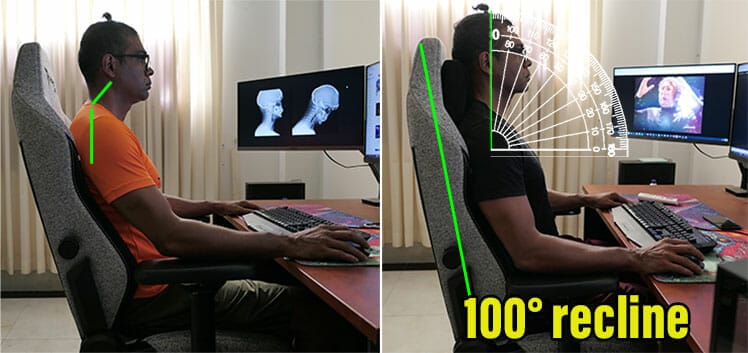
To support a 0° neck, he suggested a steeper 100° recline while using the headrest for support. It worked!
Over the next few weeks, I focused on resisting the urge to lean forward. Once that habit locked down into my muscle memory, sitting upright began running on auto-pilot.
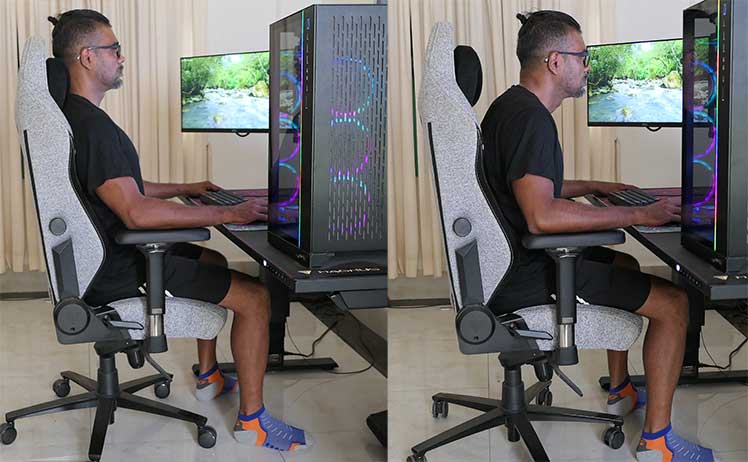
Two other esports doctors validated my strict neutral posture — with caveats:
- You need strong back muscles to sit straight for long periods.
- Striving for neutral sitting perfection is a good way to do a ‘postural reset’.
- As a regular habit, sitting with a 100° recline + 0° neck is overkill. Comfortable semi-neutral postures + frequent breaks better support musculoskeletal health.
Are Gaming Chair 0° Neck Neutral Postures Worth it?
I’ve been using the 100° recline + 0° neck method in a Secretlab Titan gaming chair for over one year. The standard posture looks similar to neutral postures in other high-end office chairs:
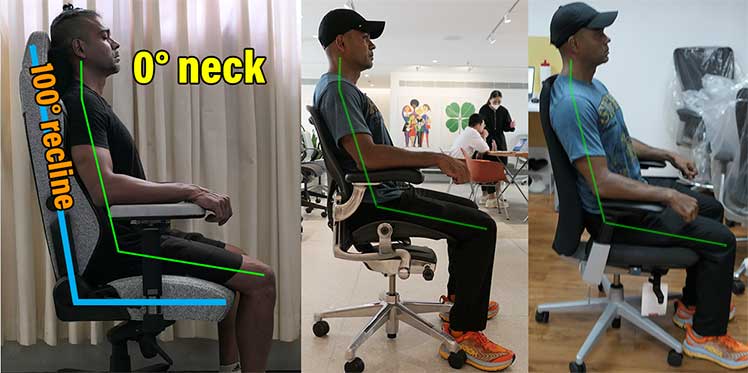
Versus my sloppier older postures, I’ve found these benefits:
- More energy and sharper focus.
- A straighter standing posture (2 cm height increase) + cosmetic improvements.
- Stronger back muscles.
Sitting straight with the screen closer to my face negates the need to lean forward. After a few days of practice sitting upright, muscles adapt. Then, more energy and sharper focus kicked in.
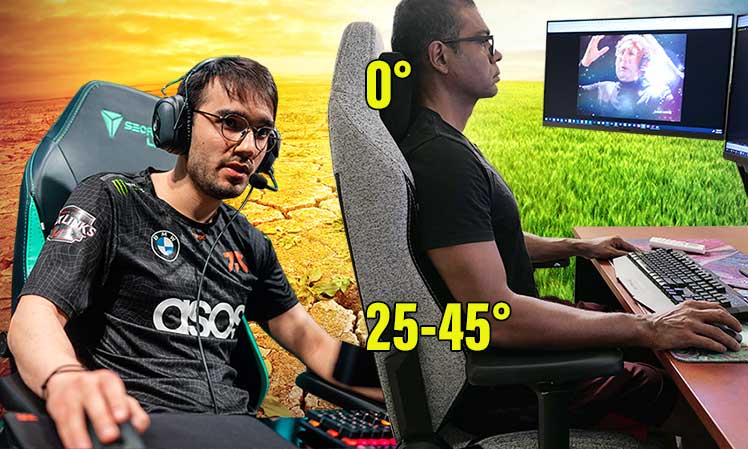
I also noticed gains in my standing posture. With stronger back muscles came a straighter stance; my measured height grew by 2 cm. As a result, my shoulders looked broader and my stomach flatter.
Learn the method, benefits, and feedback from three prominent esports doctors:
Mid-Back Office Chair 0° Neck
Using a full-back gaming chair + headrest to maintain a 0° neck demands strong back muscles. In contrast, achieving a 0° neck in a mid-back ergonomic office chair happens by design.
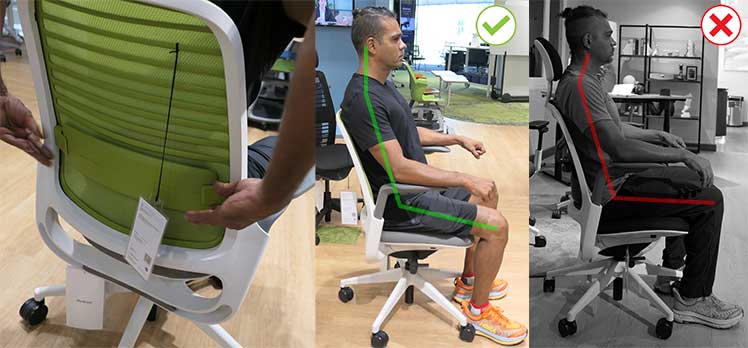
Many mid-back chairs (like the Steelcase Series 1) come with a default 100° recline. This perfectly supports textbook-neutral postures. The trick is to get the settings right, and then aim for a neutral position.
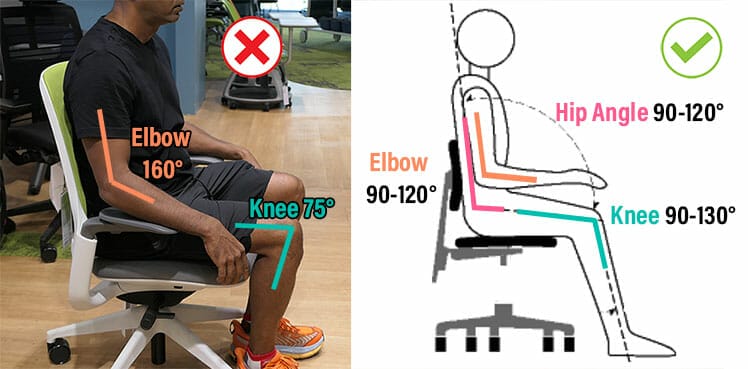
First, adjust the seat height so the hips are slightly higher than the knees. Then, adjust the lumbar support to fit just above your beltline.
After that, tuck your hips deep into the seat and plant your feet firmly on the ground. Finally, use the armrests to prop your torso up against gravity.
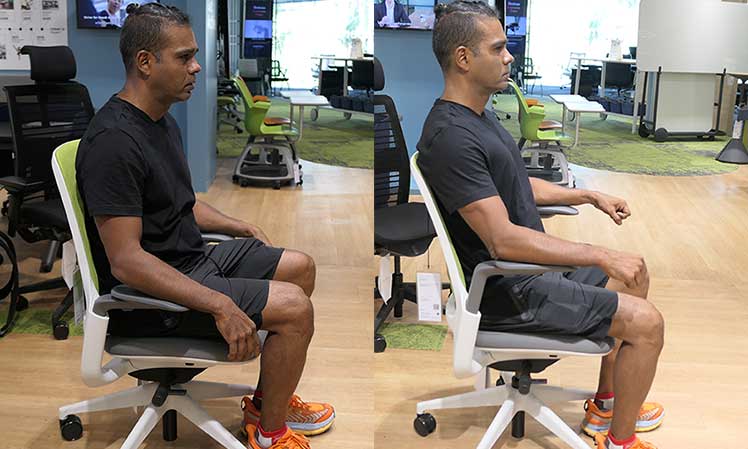
Even without strong back muscles, this method is easy for beginners to grasp and deploy. With a few days of practice, sitting this way can become a lifelong habit. Learn more:
Healthy Sitting Quickstart In A Steelcase Series 1
Related: Healthy Sitting Quickstart for Gaming AND Ergo Office Chairs
Non-Neutral Forward-Leaning Gaming
The ‘leaning forward’ gamer meme gained traction because it’s so relatable. When playing intensive video games, many gamers lean forward to maximize focus and alertness.
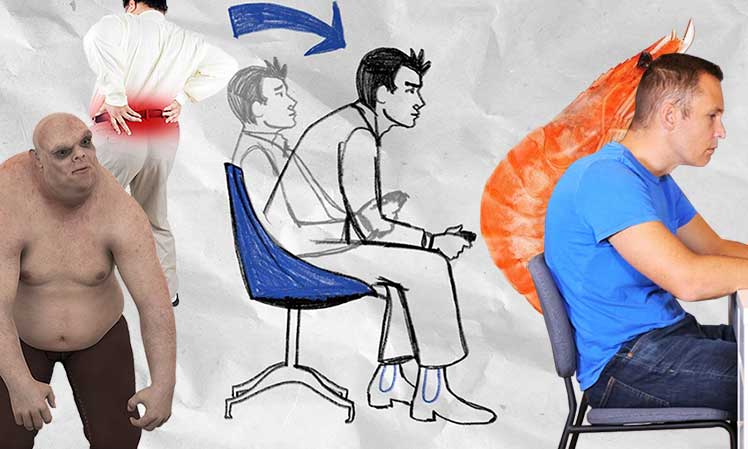
In 2021, the University of Leeds did a study that confirmed the myth. In a test playing FIFA, forward-leaning players scored twice as many goals! But there are postural drawbacks.
Specifically, sitting for long periods with a severe forward tilt is very bad for your spine. Over time, that can cause serious musculoskeletal issues.
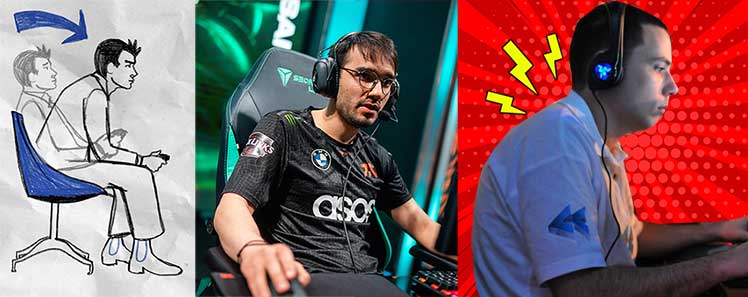
On the flip side, frequent breaks and healthy lifestyles can mitigate short periods of forward-leaning game play. Even so, there are healthier strategies for forward-leaners to consider:
Active Upright + Passive Neutral
Dr. Jordan Tsai provides physical therapy consulting for many elite esports teams. He’s also a member of the Secretlab Ergonomics Advisory Board.
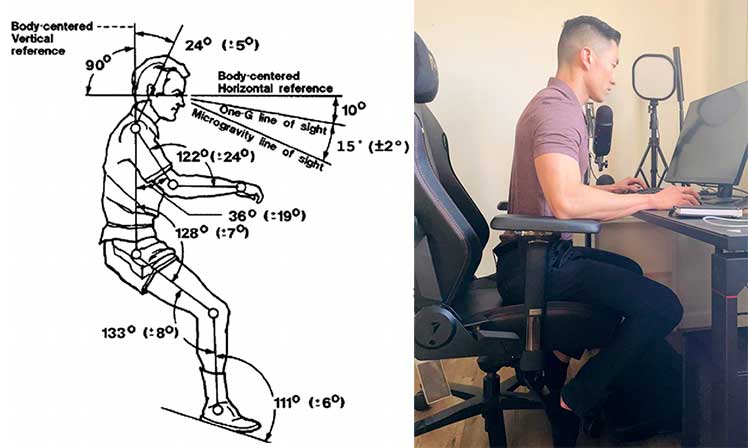
For World Health Day, he recently Tweeted his preferred forward-lean gaming style(9). From the waist up, it looks similar to one of the earliest NASA NBP diagrams.
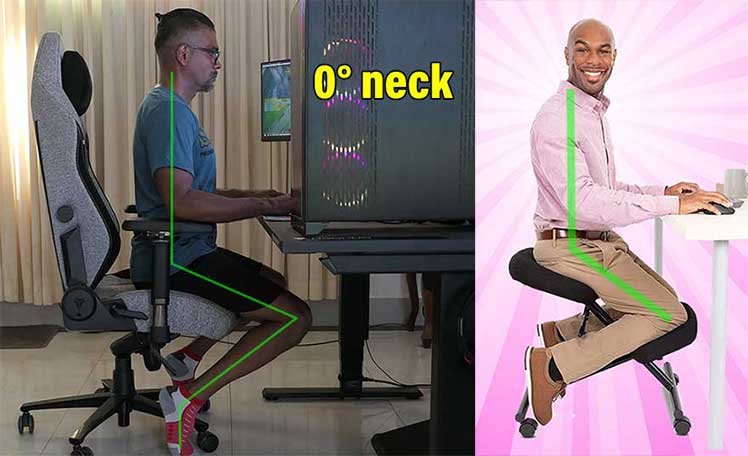
I tried to replicate his posture. It looked and felt okay-ish. But I was unsure if it was healthy. So I reached out to Dr. William Duncan, an esports physical therapist in Georgia.
He said that my posture looked good, but that I’d likely hit a fatigue wall. Then I showed him Dr. Tsai’s full demo. Besides an active upright posture, he also included a passive reclined posture in his formula.
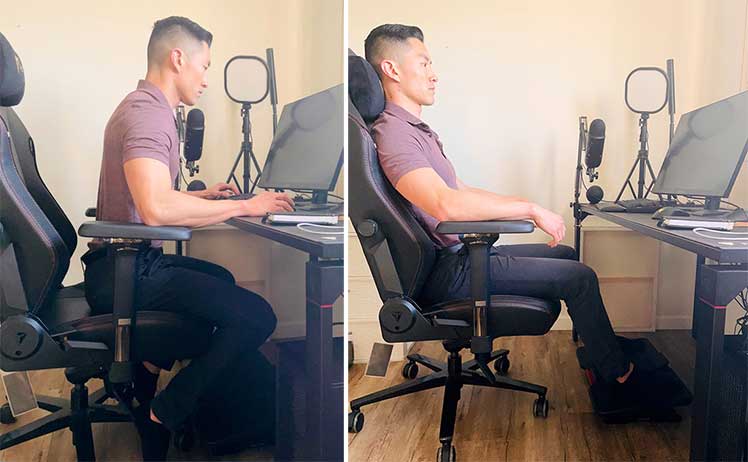
Dr. Tsai has previously told ChairsFX that movement beats perfect postures. Dr. Duncan also touts a strict active + relaxed passive combo as an excellent strategy:
Cockpit Neutral: Recline + Raised Feet
This method resembles Nissan’s 2005 ergonomic car seat prototype for consumers. That supports the spine from the pelvis to the head to boost circulation and reduce driver fatigue.
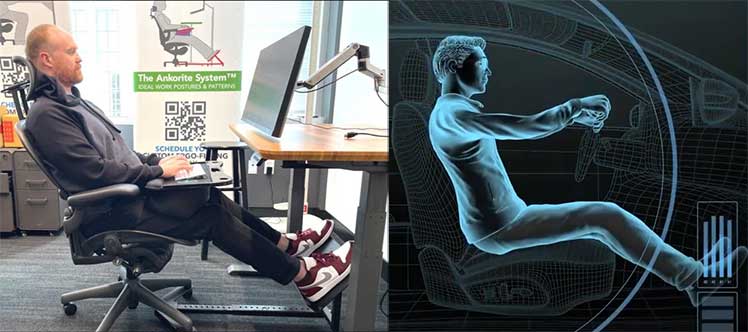
In 2023, ChairsFX received fresh validation of this concept by the founder of ErgoX, Jeannie Koulizakis. She’s a physical therapist, ergonomics researcher, inventor, and corporate consultant.
ErgoX builds Ankorite workstations for clients like NASA, the Department of Defence, and the U.S. Coast Guard(10). These are custom builds that position users into reclined postures with elevated feet.
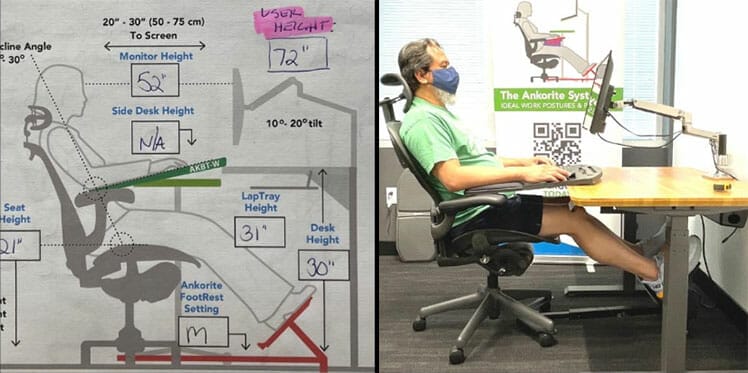
The end result mimics the posture car drivers need to operate gas pedals. This is by design:
There’s No Such Thing As A Healthy Forward Posture
After copying Dr. Tsai’s active upright posture, I took a photo, sent it to Jeannie, and asked for feedback. She was unimpressed.
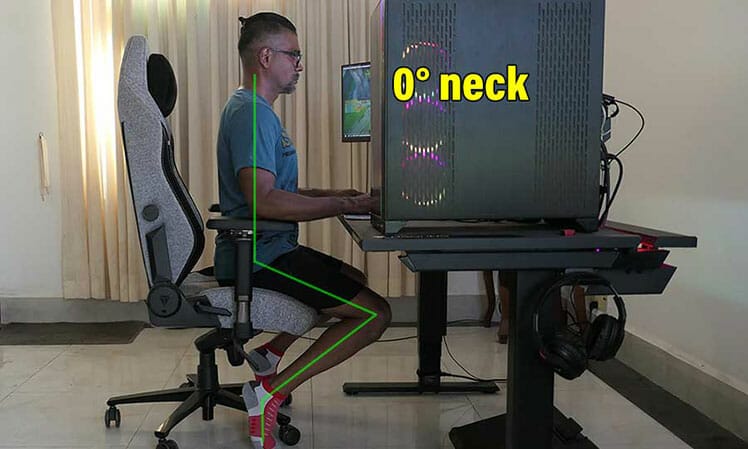
“There is no forward-leaning, on tippy toes, like you demonstrate in your pic. That is simply unhealthy on so many levels.” Her key points:
- The only reason gamers choose to lean forward: they’ve never had the luxury of gaming at a desk that supports them while they lean back.
- Once a person experiences an ideal posture to optimize focus, they don’t ever go back.
Multi-Device Ergonomic Workstations
Jeannie touts a proper workstation (chair + desk + accessories) that supports leaning back + foot compression as king. “Once gamers experience that, forward-leaning goes away completely.

For this to work, she advised that customization is key. “Like a suit, a good-fitting workstation requires that things be the right size and tailored to the unique physical attributes of the individual user.”
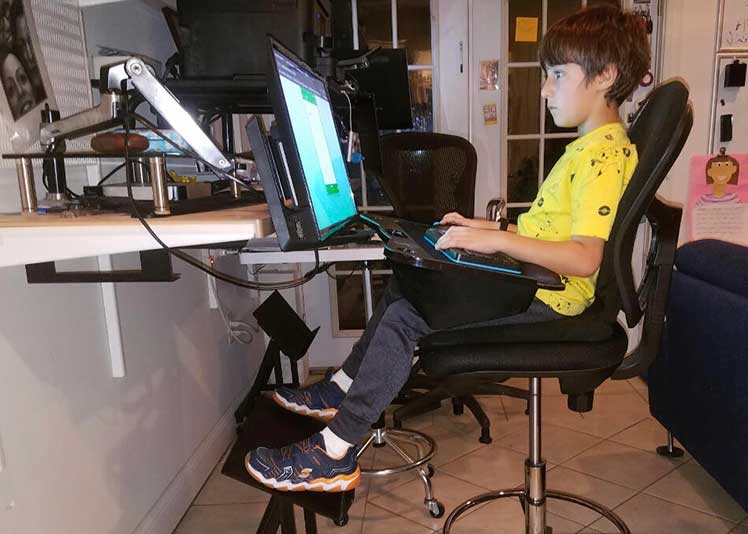
A fully-kitted Ankorite workstation (ergo chair + standing desk + accessories) can get pricey. Even so, ErgoX also shows off several cheaper builds that reach the same biomechanical ends.
Forward Vs Reclined Postures
Many studies have endorsed Ankorite-style reclines. Sitting with slightly elevated feet and knees bent beyond 90° reduces the total power absorbed by the seat.
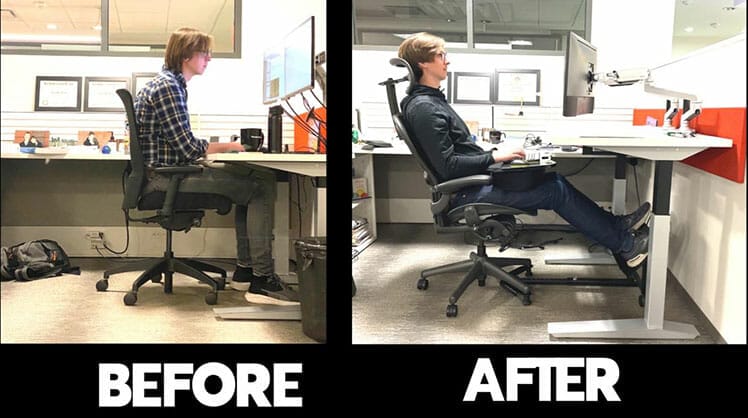
Then, instead of gravity pulling your body downward, it curls through the hips and into the spine. As a result, desk workers can enjoy healthy postures by working in sync with gravity, rather than against it.
Airplane Cockpit Postures
As a final strike against forward-leaning postures, Jeannie suggested considering cockpit postures. For instance, a good healthy pilot posture uses a supported lumbar + recline to support a straight neck and back(11).
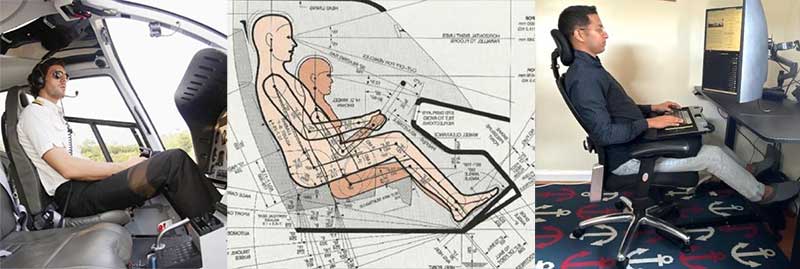
Typically, pilots sit with a mild recline + elevated feet. This ensures healthy, relaxed postures without muscle tension. As a result, they can maintain a straight neck and a consistent straight-ahead view for long periods without fatigue.
Standing Desk Multi-Device Neutral
The 5th edition HFE calls for multi-device workstations that support good back and neck posture + movement. Some chairs (like the Steelcase Gesture) are marketed as having mobile-supporting arms.
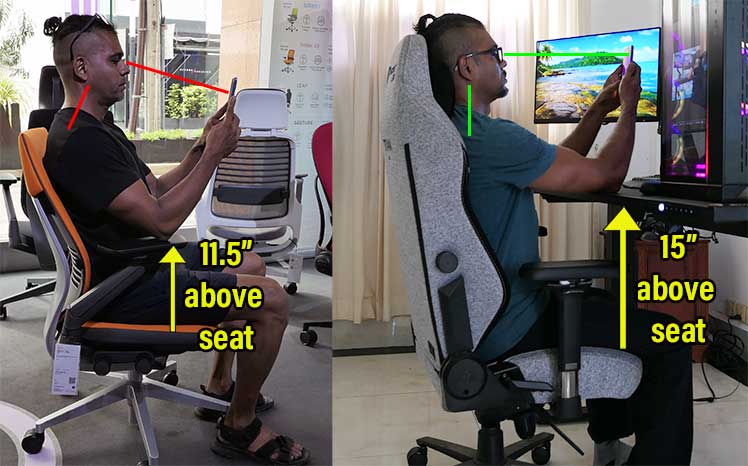
In practice, the mobile support provided by all ergo chairs is toy-like compared to that of a sit-to-stand desk.
Standing Desk Benefits
Seven months ago, I added a Secretlab Magnus Pro Sit-To-Stand Desk to my arsenal. That allowed me to maintain 0° neck postures while sitting, standing, and mobile computing.
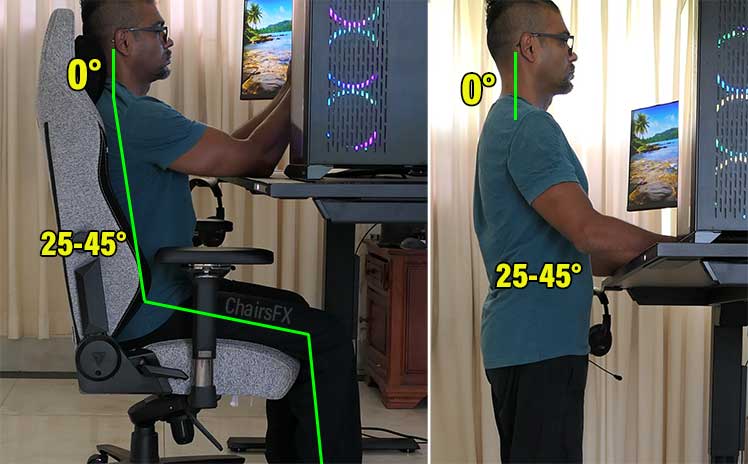
Beyond multi-device spinal support, standing desks also supercharge movement. Combined, this functionality perfectly addresses 5th Edition HFE requirements.

For instance, moving from a seated to a standing position (or vice versa) replicates a squat. That works your hips, bones, muscles, and joints. Compared with stiff sitting in fixed positions for long hours, sit-to-stand transitions improve both cardiovascular and cerebrovascular health.
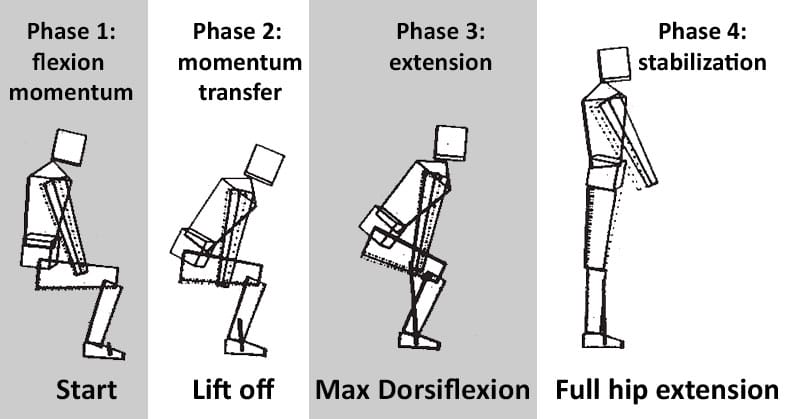
That yields proven earning, memory, and cognitive functions(12). These benefits are so profound that they’ve become an integral part of many pro esports performance optimization programs. Learn more:
Problems Caused By Poor Sitting Habits
In prehistoric times, humans were lean and athletic. Peak fitness was inspired by the need to survive. Over centuries, innovations like agriculture and steam engines made food more accessible with less effort.

As a result, fitness tendencies plummeted. In the modern era, excessive sedentary behavior has wreaked devastation in two ways.

First, it underworks the body, leading to physical and metabolic atrophy. Second, it misaligns the spine and surrounding muscles, which causes severe musculoskeletal breakdowns.
Excessive Sedentary Behavior
One-third of the global population aged 15 or older doesn’t get enough exercise. A 2020 survey found Americans spending 7.7 hours off their feet (55% of waking hours). In South Korea, the average adult is physically inert for 8.3 hours per day(13).
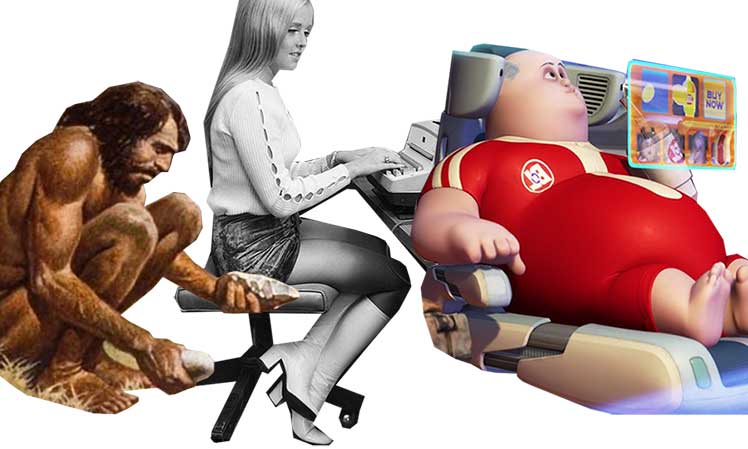
Extreme sedentary behavior impairs metabolism, reduces cardiac output, and slows circulation. That causes weight gain, adiposity, and elevated chronic inflammation.
Over time, these effects cause wide-ranging adverse impacts on the human body:
- Metabolic disorders: diabetes, hypertension, dyslipidemia, etc.
- Musculoskeletal disorders: arthralgia, osteoporosis, arthritis, gout, etc.
- Mental disorders: depression, cognitive impairment (brain fog)
In prehistoric times, humans were lean, fit, and athletic. Since then, global lifestyles have become increasingly sedentary.

As a result, around 50% of American adults (117 million people) now suffer from preventable chronic diseases(14). These include:
- Obesity: waist circumference increases by 3.1 cm with a 10% increase in sedentary time. With more weight to carry, patients feel compelled to move less.
- Diabetes: the prevalence of type 2 diabetes increases as sedentary time does. Symptoms include tingling extremities, very dry skin, excessive urination, and blurry vision.
- Hypertension: sedentary behaviors reduce blood pressure, altering cardiac output and total peripheral vascular resistance. Symptoms include headaches, an irregular heartbeat, nosebleeds, and fatigue.
- Cancer: prolonged sitting increases colorectal, endometrial, ovarian, and prostate cancer risks. It has also been reported to increase cancer mortality (mainly in women).
- Osteoporosis: sedentary behavior lowers the bone mineral density of the femur and hip sub-regions. As a result, bones become brittle and easy to break.
- Depression: mentally passive sedentary behaviors (like watching TV) increase depression risks.
Musculoskeletal Disorders
The human body isn’t designed to sit for long periods. Doing so slows metabolism, circulation, and cardiac output. Beyond physical inertia, it also wreaks havoc on the musculoskeletal system.
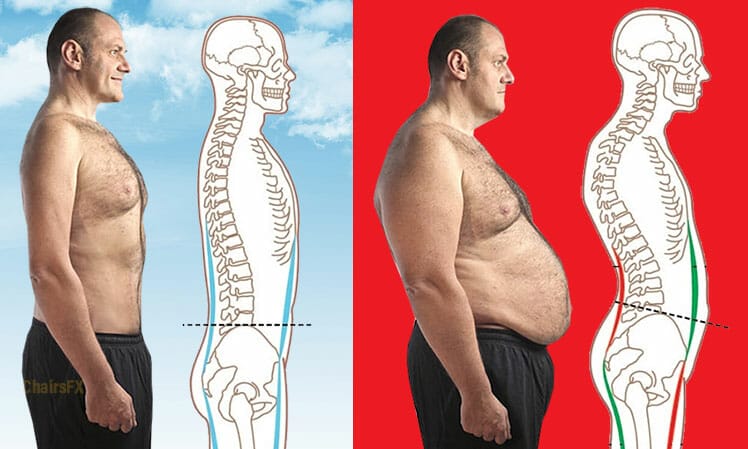
This is no trivial matter. Around 1.7 billion people suffer from MSDs (22% of the global population). Lower back pain (LBP) is the leading cause of disability in 160 countries.
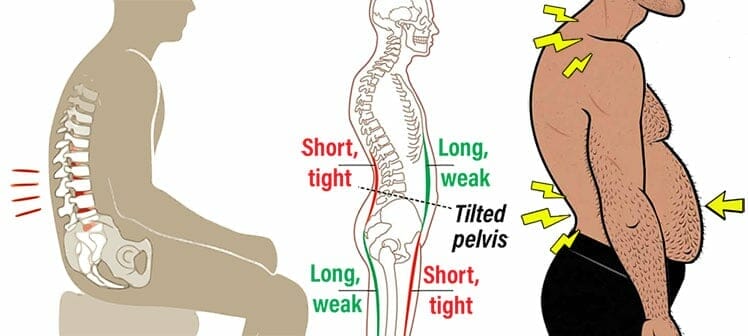
Lower back pain is symptomatic of a misaligned spine. That partly explains why studies estimate around 80% of American adults suffer from anterior pelvic tilt.
Other common MSDs include:
- Wrist disorders: 4 million Americans suffer from carpal tunnel syndrome.
- Neck pain: the fourth-leading cause of disability in America.
- Shoulder pain: causes around 4.5 million USA doctor visits and $3 billion in associated health costs.
- Elbow and forearm pain: 1-3% of all Americans suffer from elbow tendonitis, aka tennis elbow.
- Low back disorders: 31 million Americans are suffering from low back pain at any given time.
Conclusion
NASA discovered neutral postures in outer space in 1973. In microgravity, neutral body postures (NBP) exert the least amount of muscular strain. NASA’s earliest NPB sketches show upright active postures.

In 2005, the Nissan Motor Corporation used NBP to develop ergonomic car seats. These are passive reclined postures.
Circa 2023, these active and passive extremes remain relevant. Dr. Jordan Tsai’s upright active style offers a healthy alternative to forward-leaning gamers. In contrast, Ankorite systems mimic the ergo car seat reclined + elevated feet style.
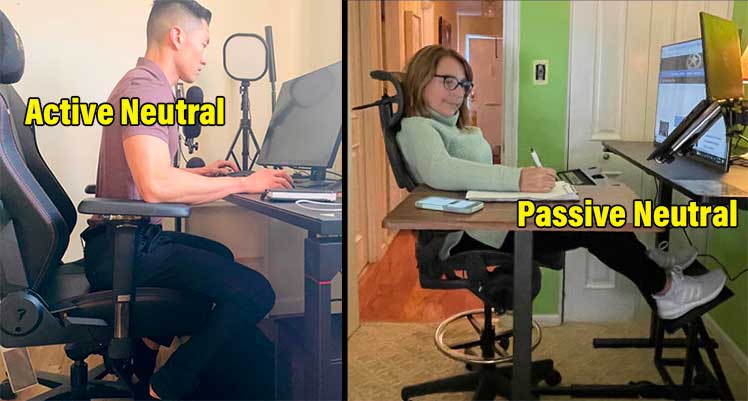
Between those two extremes are six variations, making eight viable neutral computing posture options. Choose whichever style suits your needs.
For instance, here at ChairsFX, I use a gaming chair + strict neutral 0° neck style. Top esports docs have assessed my posture as viable but overkill: sloppy postures + healthy movement can achieve similar results.
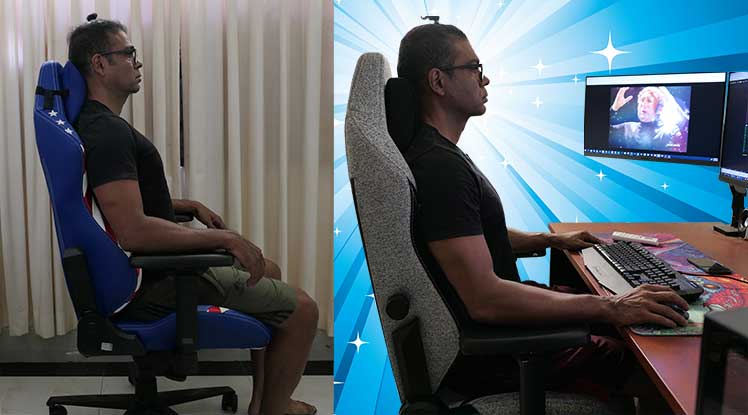
Even so, I like sitting this way. With frequent breaks + regular exercise + a sit-stand desk, I’ve enjoyed no issues and many benefits.
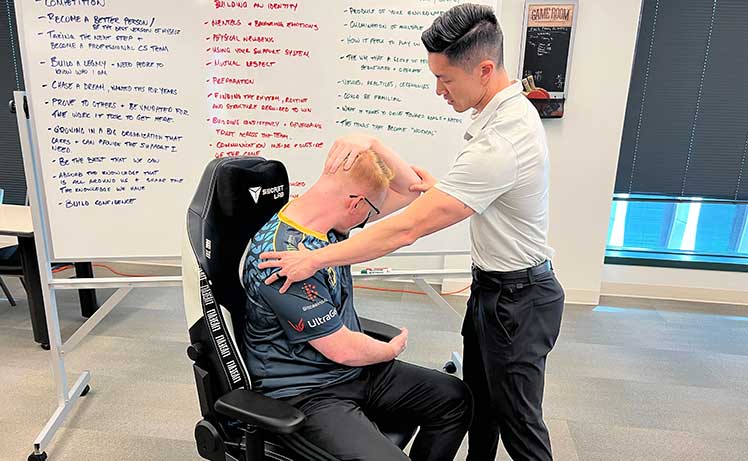
In a similar fashion, I suggest choosing whichever neutral sitting style aligns with your needs. Regardless of which you choose, follow the esports blueprint to ensure the best results:
Esports Optimization: Movement Beats Perfect Posture
Footnotes
- NASA Aeronautics & Space Administration. ‘NASA-STD-3000 Man-Systems Integration Standards’. 1987. https://msis.jsc.nasa.gov/, (accessed 8 March 2022).
- D D Harrison, et al. ‘Sitting biomechanics part I: review of the literature’, J Manipulative Physiol Ther. 1999 Nov-Dec;22(9):594-609. https://pubmed.ncbi.nlm.nih.gov/10626703/, (accessed 8 March 2022).
- Kaja Kastelic, et al. ‘Sitting and low back disorders: an overview of the most commonly suggested harmful mechanisms’. Collegium Antropologicum 42(1):73-79, March 2018. Read abstract (accessed 20 Feb. 2022).
- K. Han Kim, et al. ‘Neutral Body Posture in Spaceflight’. NASA Johnson Space Center. Read the PDF (accessed 7 May 2023).
- USA Artistic Swimming, ‘Understanding Neutral Spine Position and the Core Muscles’. July 24, 2013. https://www.teamusa.org/USA-Artistic-Swimming/Features/2013/July/24/Understanding-Neutral-Spine-Position-and-the-Core-Muscles, (accessed 8 March 2022).
- ‘Zero Gravity Inspired Car Seat’, Nissan Motor Corporation, April 18, 2014. https://www.nissan-global.com/EN/TECHNOLOGY/OVERVIEW/zero_gravity_inspired_car_seat.html (accessed 12 March. 2022).
- Jennifer Pynt, et al. ‘Seeking the Optimal Posture of the Seated Lumbar Spine’. Physiotherapy Theory and Practice 17:5, 2001, https://www.researchgate.net/publication/224029048_Seeking_the_Optimal_Posture_of_the_Seated_Lumbar_Spine, (accessed May 7, 2023).
- Youtube, “Set up like S1mple – WITH CFG!” ESL Counter-Strike, March 18, 2022, https://youtu.be/REjATuWa5TY.
- Dr. Respawn Twitter. “Happy World Health Day!” April 6, 2023. https://twitter.com/DrJordantsai/status/1643976031559364613. (accessed 4 May 2023)
- ErgoX.com. “Computer Workspace Design”. https://www.ergorx.com/. (accessed 4 May 2023)
- Pro Aviation Tips. ‘Correct Pilot Seating Position: Why Is It So Important?’. January 22, 2023. https://proaviationtips.com/pilot-seating/. (accessed 9 May 2023)
- Christopher Bergland. ‘Moving Your Body Is Good for Your Mind’. The Athlete’s Way Sept. 25, 2014. https://www.psychologytoday.com/us/blog/the-athletes-way/201409/moving-your-body-is-good-your-mind (accessed 2 August 2022).
- Park JH, et al. ‘Sedentary Lifestyle: Overview of Updated Evidence of Potential Health Risks’, Korean J Fam Med. 2020;41(6):365-373. doi:10.4082/kjfm.20.0165 (accessed 12 March. 2022).
- CDC, ‘Health and Economic Costs of Chronic Diseases’, 23 June, 2021, https://www.cdc.gov/chronicdisease/about/costs/index.htm, (accessed 5 Jan. 2022).






